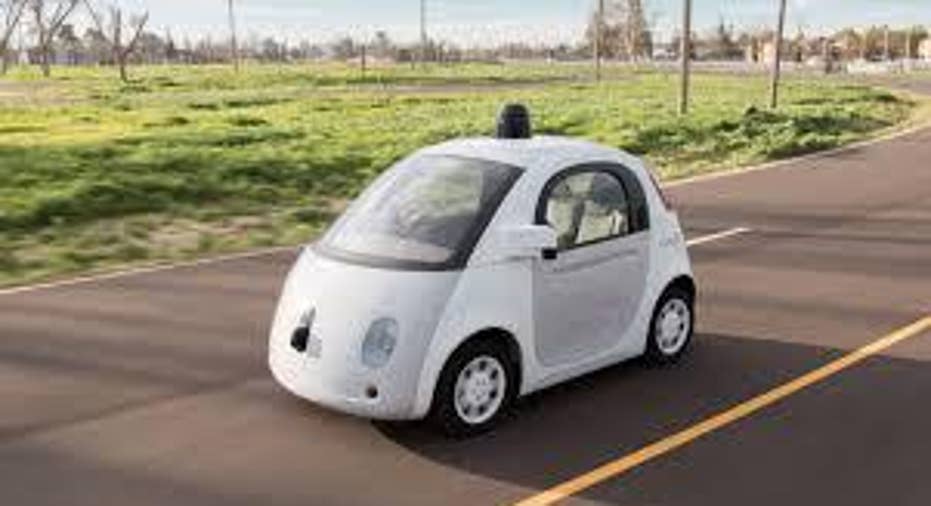Green Lights and Red Flags for Google, General Motors, and Ford in This New Government Report

Image source: Google.
Government regulation affects pretty much every business, and the auto industry is no exception. But when technology starts advancing faster than regulations can keep up, trouble ensues.
That's where automakersGeneral Motors andFord, along with wannabe automaker Google and parent companyAlphabet , find themselves today in their quests to bring a driverless car to market. And while none of these companies seems to be pulling out in front of the others with technology, all three have left the aging auto regulations in the dust.
The National Highway Traffic Safety Administration recently released a preliminary report outlining some of the regulatory hurdles to bringing driverless cars to market. And it looks like they may cause the most trouble for Google.
Don't shoot the messengersJust because NHTSA is the one bringing up these issues doesn't mean it's hostile to the prospect of autonomous vehicles. On the contrary, Transportation Secretary Anthony Foxx had this to say in January at the North American International Auto Show: "In 2016, we are going to do everything we can to advance safe, smart, and sustainable transportation innovations. We are bullish on automated vehicles."
In a March 16 speech in Dearborn, Michigan, NHTSA administrator Mark Rosekind also voiced his full support for driverless cars: "[W]e will spend the next year using all the tools available to us to encourage the development of life-saving technology innovations and to make sure we maximize their safety potential."
So that sounds good for GM, Ford, and Google: The NHTSA and the Secretary of Transportation are on their side. But even government officials have limits to what they can and can't do.
On the booksUnfortunately for the companies, it's very difficult to change an existing federal vehicle safety standard. It requires alengthy proposal and review process, including analyzing public comments and developing compliance tests. It's easier to just develop new technologies that conform to existing standards.
But as NHTSA reinforced in a recent letter to Google, "Those standards were drafted at a time when it was reasonable to assume that all motor vehicles would have a steering wheel, accelerator pedal, and brake pedal, almost always located at the front left seating position, and that all vehicles would be operated by a human driver."
So when Federal Motor Vehicle Safety Standard 135 dictates that brakes on a light vehicle "shall be activated by means of a foot control," it doesn't matter that a fully autonomous car wouldn't use foot controls (or feet, for that matter): The standard would need to be changed for the vehicle to comply. Also, a test would need to be developed to ensure compliance.This is especially problematic for Google, which is developing fully autonomous vehicles that don't have traditional controls.
No way outNHTSA's recent report found that the current safety standards are littered with language referencing the driver's seating position, hands, feet, line of vision, and so on, all of which would need to be updated to make Google's driverless cars compliant.
Conversely, for GM and Ford, whose efforts have centered on traditional vehicle design with a human seated behind the wheel, the report concluded there were "few barriers" to compliance. This is good for Ford, which has announced plans to test autonomous vehicles on snowy road conditions, and for GM, which just bought autonomous-car startup Cruise Automation.
So what can Google do? Well, it can wait. NHTSA's Rosekind said his agency was working quickly: "public information meetings beginning in April [will] help us develop operational guidance for automated vehicles."That may be lightning-fast for a government agency, but the meetings are just the first step on a lengthy regulatory journey. It will almost certainly last past January 2017, when there's no guarantee that this will remain a priority for a new administration.
But Google has few other options. As an interim step, it can apply for an exemption to some of the standards.To be successful, Google would have to be "able to demonstrate that features of [its] products provide equivalent levels of safety to those required by the FMVSS."That may be difficult.
Or Google can just stick to developing automated cars with human drivers, like the ones it has been testing. However, that leaves it in a very crowded space with fewer opportunities to use its technological and design resources to create something truly unique.
The Foolish bottom lineAutomated vehicles are coming, probably sooner rather than later,and it's good that the government recognizes that fact and is trying to address it. However, the speed of government is no match for the speed of innovation from some of America's foremost companies.
Although this process may set Google's fully autonomous efforts back a few years, the company is unlikely to abandon its efforts. And now that NHTSA has clarified the lack of barriers, Ford and GM are likely to continue full-throttle as well. All in all, things are looking very good for the future of driverless cars, and the companies that invest in them now. However, investors who had hoped to see a fully autonomous Google Car on the roads soon should rethink their timeline.
The article Green Lights and Red Flags for Google, General Motors, and Ford in This New Government Report originally appeared on Fool.com.
Suzanne Frey, an executive at Alphabet, is a member of The Motley Fool's board of directors. John Bromels owns shares of Alphabet (A and C shares), and Ford. The Motley Fool owns shares of and recommends Alphabet (A and C shares), and Ford. The Motley Fool recommends General Motors. Try any of our Foolish newsletter services free for 30 days. We Fools may not all hold the same opinions, but we all believe that considering a diverse range of insights makes us better investors. The Motley Fool has a disclosure policy.
Copyright 1995 - 2016 The Motley Fool, LLC. All rights reserved. The Motley Fool has a disclosure policy.